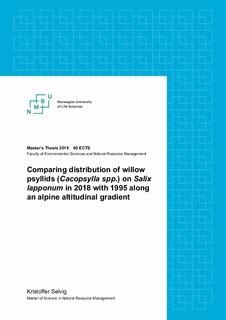| dc.contributor.advisor | Birkemoe, Tone | |
| dc.contributor.advisor | Klanderud, Kari | |
| dc.contributor.advisor | Roos, Ruben Erik | |
| dc.contributor.author | Selvig, Kristoffer | |
| dc.coverage.spatial | Norway, Finse | nb_NO |
| dc.date.accessioned | 2019-09-25T12:32:43Z | |
| dc.date.available | 2019-09-25T12:32:43Z | |
| dc.date.issued | 2019 | |
| dc.identifier.uri | http://hdl.handle.net/11250/2618752 | |
| dc.description.abstract | The psyllid (Cacopsylla spp.) population on Salix lapponum in the alpine areas of southern Norway, in an altitudinal gradient between Haugastøl and Finse, were thoroughly studied in 1995. The results were presented and published in Hill et. al. 1998. With rise in global air temperature and observed changes in insect communities over the last years, a prediction could be made that there have been changes in the psyllid population in this area from 1995 to 2018. Current findings were compared with the ones from 1995. I predicted changes to have happened in egg-laying location on the Salix shrubs, with a higher proportion of eggs laid on leaves rather than catkins, and changes in psyllid species composition.
I resampled the same sites along the gradient, which is located between 998 and 1222 m a.s.l. The methodology described in Hill et. al. 1998 was followed closely. Measurements were done of selected Salix shrubs while taking samples of leaves and catkins in early June. Enclosures were attached on leaf and catkin branches, trapping the developing psyllids inside. Further enclosures were added on leaf branches in July. All enclosures were collected in August, after any entrapped specimens would have developed into adults. The collected samples were measured and counted in the lab, followed by statistical analyses looking for trends and comparing the data with the 1995 findings.
Some differences were found in the egg placement on the shrubs, but the findings were not significant. The number of eggs on catkins had a significant relationship with catkin developmental stage and observed catkin density. Only one species of the adult psyllids were found in the resampling, and their mean abundance was significantly lower for most sites in 2018. I interpret the difference in the results as an effect of phenology having shifted from 1995 or the methods being slightly different. The temperature increase will likely also be a part of the explanation, with the 2018 summer months being abnormally warm and sunny. | nb_NO |
| dc.description.abstract | Bestanden av sugere (Cacopsylla spp.) på lappvier (Salix lapponum) i de fjellområdene i Sør-Norge, i en høydegradient mellom Haugastøl og Finse, ble grundig studert i 1995. Resultatene ble presentert og publisert i Hill et. al. 1998. Med økning i global lufttemperatur og observerte endringer i insektsamfunn i løpet av de siste årene, kan det antas at det har vært endringer i bestanden av sugere i dette området fra 1995 til 2018. De nylige funnene ble sammenlignet med de fra 1995. Jeg forutså at det hadde oppstått endringer i hvor eggene ble lagt på vierbuskene, med en høyere andel egg lagt på blader enn rakler, og endringer i artssammensetningen av voksne sugere.
Jeg samlet nye prøver fra de samme innsamlingsstedene langs gradienten, som ligger mellom 998 og 1222 m.o.h. Metoden beskrevet i Hill et. al. 1998 ble fulgt tett. Målinger ble gjort for utvalgte lappvierbusker og prøver av blader og rakler ble samlet inn i begynnelsen av juni. Innkapslinger ble festet på grener med hhv. blader og rakler, og lukket dermed inne eventuelle sugere som ville utvikle seg på grenene. Ytterligere innkapslinger ble satt på grener med blader i juli. Alle innkapslinger ble samlet inn i august, etter at de eventuelle sugerne ville ha utviklet seg til voksne individer. De innsamlede prøvene ble målt og opptalt i laboratoriet, etterfulgt av statistiske analyser for å finne trender og for å sammenligne dataene med 1995-funnene.
Noen forskjeller ble funnet i eggenes plassering på buskene, men funnene var ikke signifikante. Antall egg på raklene hadde en betydelig sammenheng med raklenes utviklingsstadie og deres observerte tetthet. Bare én av sugerartene ble funnet i de nye prøvene av voksne individer, og deres gjennomsnittlige antall var betydelig lavere for de fleste innsamlingssteder i 2018. Jeg tolker forskjellen i resultatene som en effekt av endret fenologi fra 1995 eller at metodene er litt forskjellige. Temperaturøkningen vil trolig også være en del av forklaringen, da sommermånedene i 2018 var unormalt varme og solfylte. | nb_NO |
| dc.language.iso | eng | nb_NO |
| dc.publisher | Norwegian University of Life Sciences, Ås | nb_NO |
| dc.rights | Attribution-NonCommercial-NoDerivatives 4.0 Internasjonal | * |
| dc.rights.uri | http://creativecommons.org/licenses/by-nc-nd/4.0/deed.no | * |
| dc.subject | Finse | nb_NO |
| dc.subject | Salix lapponum | nb_NO |
| dc.subject | Entomology | nb_NO |
| dc.subject | Entomologi | nb_NO |
| dc.subject | Cacopsylla propinqua | nb_NO |
| dc.title | Comparing distribution of willow psyllids (Cacopsylla spp.) on Salix lapponum in 2018 with 1995 along an alpine altitudinal gradient | nb_NO |
| dc.type | Master thesis | nb_NO |
| dc.description.version | submittedVersion | nb_NO |
| dc.subject.nsi | VDP::Mathematics and natural science: 400 | nb_NO |
| dc.description.localcode | M-NF | nb_NO |

